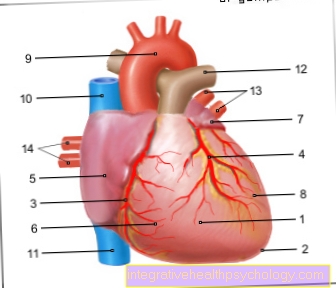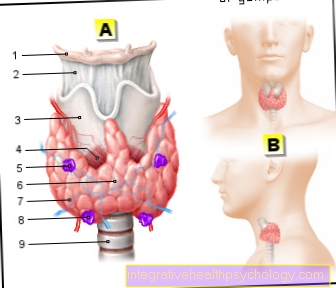Pressure ulcer
definition

The popular term Pressure ulcer refers to the localized death of the skin and the underlying soft tissues due to the insufficient supply of the tissue with oxygen as a result of pressure load.
Synonyms
Pressure sores, bedsores, decubitus ulcers, lat. decumbere (lie down)
Symptoms
Depending on the tissue damage, the pressure ulcer is divided into four degrees.
Grade I: There is reddening of the skin in the area of the undamaged skin surface. In addition to the reddening, there is often a warming of the skin observed.
Grade II: Superficial layers of the skin are damaged. The skin shows superficial defects at the pressure point, which are manifested by blistering and abrasion of the skin.
Grade III: In stage III, deep soft tissue damage is visible. There is significant tissue damage that extends to the muscle - and bone tissue is sufficient, with the bone still intact.
Grade IV: There is deep tissue damage that extends to the bone.
Decubitis can be divided into 3 stages:
Stage A: The wound is clean and covered with granulation tissue. Necroses are not found at this stage.
Stage B: The wound is covered with greasy granulation tissue. There is no infiltration into the surrounding tissue. Necrosis is not found at this stage.
Stage C: The wound is covered with a greasy granulation tissue. There is an infiltration into the surrounding tissue. This stage is found today in combination with general infections
Development of the decubitus
For the creation of the Pressure ulcer the pressure load on the tissue is of decisive importance. If the pressure on the tissue is below the capillary pressure of 25-35 mmHg, the venules (blood vessels that lead to the heart) are blocked, with a resulting disruption of the Cardiovascular system. This Circulatory disorder has yet to be corrected (reversible).
However, if the pressure values are above 35 mmHg, not only the venules but also the aterioles (blood vessels from the Heart lead away, i.e. oxygen-rich) and depending on the time with which the pressure acts on the tissue, there is an undersupply and ultimately the destruction of the corresponding tissue.
causes
There are a number of factors that contribute to the development of a pressure ulcer:
- Vascular disease
- advanced age
- Multimorbidity (presence of various serious illnesses)
- Stool and urinary incontinence
- Bedridden
- Cachexia (emaciation)
- Diabetes (diabetes mellitus)
- Loss of protein in various diseases
- long-term surgical interventions
- serious underlying diseases
Predilection sites = place of frequent emergence
In over 80% of cases, a pressure ulcer develops on the buttocks, the greater trochanter, on the Fibula head, on the outside or inside of the ankle or on the heel bone.
diagnosis
In addition to a thorough clinical examination, diagnostic measures include an X-ray to rule out a Osteomyelitis (inflammation of the bones) and wound swabs are necessary to assess the tissue damage.
In the lower extremity area should also chronic arterial occlusive disease, as well as a Polyneuropathy be excluded.
therapy
After the diagnosis has been confirmed, treatment must be appropriate to the phase and patient. Correct positioning with regular repositioning is necessary as a prophylactic measure. The most important goal is to relieve the pressure.
Besides the Position therapy must be a thorough skin care with regular examination of the wound status. To avoid friction on the skin it is necessary to avoid moisture and wetness.
With deep tissue damage, regular wound cleaning, which includes the removal of dead tissue, is essential. Appropriate wound dressings and disinfectants are available for wound treatment. In the deeper stages, surgical therapy must be considered to avoid infection. The damaged tissue is removed and the resulting defect plastic-surgical covered.
The treatment (therapy) of existing bedsores should be done by experienced doctors.
Complications
If the pressure ulcer is very advanced, there is a risk of developing osteomyelitis or a sepsis (Blood poisoning) developed.
forecast
Complete healing can still be achieved with degrees I and II.
In degrees III and IV, only defect healing is possible
For this reason, the most important thing is prophylaxis to avoid pressure ulcers.
Summary
The pressure ulcer can occur in many places, but especially in the area of protruding bones. A lack of mobility, friction and pressure leads to a reduced blood flow to the tissue with subsequent death of the soft tissue.
Elderly and immobile people with diabetes are particularly affected / diabetes or circulatory disorders as well as patients with malnutrition and general immune deficiency. The most commonly affected areas of the body are the heels, ankles, pelvic bones and the fibula head.





























